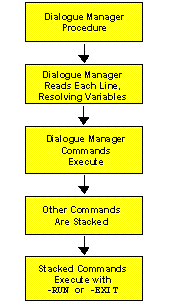&APPROOT |
Physical location of the APPROOT directory.
|
Directory name.
|
&DATE |
Current date.
|
MM/DD/YY |
&DATEfmt |
Current date.
|
fmt is any combination of YYMD, MDYY, and
so on.
|
&MDY |
Current date. Useful for numerical comparisons.
|
MMDDYY |
&MDYY |
Current date (four-digit year).
|
MMDDCCYY |
&DMY |
Current date.
|
DDMMYY |
&DMYY |
Current date (four-digit year).
|
DDMMCCYY |
&YMD |
Current date.
|
YYMMDD |
&YYMD |
Current date (four-digit year).
|
CCYYMMDD |
&FOCFOCEXEC |
Current running procedure.
|
Manages reporting operations involving many
similarly named requests that are executed using EX. &FOCFOCEXEC
enables you to easily determine which procedure is running. &FOCFOCEXEC
is specified within a request or in a Dialogue Manager command to display
the name of the currently running procedure.
|
&FOCINCLUDE |
Current included procedure.
|
Manages reporting operations involving many
similarly named requests that are included using -INCLUDE. &FOCINCLUDE
is specified within a request or in a Dialogue Manager command to
display the name of the current included procedure.
|
&ECHO |
Current echo tracing value.
|
ON, OFF, or ALL |
&FOCMODE |
Operating environment.
|
AS/400, MSO, UNIX, VMS or WINNT. You
cannot override the system-supplied value. MSO
is the value returned on z/OS. If it is necessary to further test
for server PDS verses HFS Deployment. The following may be used: -? SET TEMP &XYZ
-SET &XYZ = IF &XYZ EQ 'MVS' THEN 'PDS' ELSE 'HFS' ; |
&FOCPRINT |
Current print setting.
|
ONLINE
OFFLINE |
&FOCREL |
Source code release number.
|
Release number (for example, R727706D).
|
&IORETURN |
Value returned after the last Dialogue Manager
-READ or -WRITE operation.
|
0 Successful operation.
1 End
or failure.
|
&RETCODE |
Return code value from execution of a server
or operating system command.
Referencing &RETCODE forces the
execution of all stacked commands, like the command -RUN.
|
Any value returned by a command is valid (for
example, CALLPGM flag values), but zero is considered normal (successful) execution.
The
one exception is the &RETCODE value of dash operating system
commands, such as -DOS, -UNIX, -VMS, -AS/400, and -WINNT, represent
the success, not of the command they are running, but of the ability
of the server to spawn out to the OS and run the command. In this
case, the &RETCODE value is normally zero because it reflects
that the spawn executes normally regardless of the results of the
specific command. For this case, the amper variable &EXITRC
should be used to check the command result or the non-dash version
of the command should be used.
|
&EXITRC |
Return code value from execution of an operating
system command.
Referencing &EXITRC forces the execution
of all stacked commands, like the command -RUN.
|
Any value returned by a command is valid, but
zero is considered normal (successful) execution.
|
&TOD |
Current time. When you enter FOCUS, this
variable is updated to the current system time only when you execute
a MODIFY, SCAN, or FSCAN command. To obtain the exact time during
any process, use the HHMMSS subroutine.
|
HH.MM.SS |
&FOCCODEPAGE |
Code page of the server when NLS
is configured else varies by platform when not configured.
|
Numeric, such as 297, not changeable.
|
&FOCLANGCODE |
Language of the server when NLS
is configured, else blank.
|
String, such as FRE, not changeable.
|
&LINES |
Number of lines printed in
last TABLE.
|
Numeric, not changeable.
|
&RECORDS |
Number of records retrieved for
last TABLE/GRAPH.
|
Numeric, not changeable.
|
&TRANS |
Number of transactions processed.
|
Numeric, not changeable.
|
&ACCEPTS |
Accepted transactions.
|
Numeric, not changeable.
|
&NOMATCH |
Nomatch rejects.
|
Numeric, not changeable.
|
&FORMAT |
Format errors.
|
Numeric, not changeable.
|
&INVALID |
Invalid conditions.
|
Numeric, not changeable.
|
&DUPLS |
Duplicates rejected.
|
Numeric, not changeable.
|
&INPUT |
Segments input.
|
Numeric, not changeable.
|
&CHNGD |
Values updated.
|
Numeric, not changeable.
|
&DELTD |
Segments deleted.
|
Numeric, not changeable.
|
&RETCODE |
Value after DOS command.
|
Numeric, not changeable.
|
&BASEIO |
Number of input/output operations.
|
Numeric, not changeable.
|
&READS |
Read operations from external file.
|
Numeric, not changeable.
|
&REJECTS |
Number of rejected transactions.
|
Numeric, not changeable.
|

